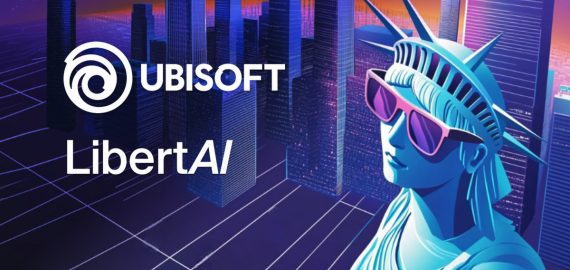Digital Fashion: A Retrospective Look at a Year of Innovation, Trends and Challenges


In Brief
With the increasing popularity of gaming and virtual worlds, fashion brands and designers have begun to create digital clothing and accessories for avatars. These digital items can be purchased and worn exclusively in virtual environments, allowing users to express their style in new and exciting ways.
The gaming industry continues to thrive, becoming a multi-billion dollar market. In 2023, gaming revenue will reach a staggering $384.90 billion.

About the Author
Anastasia Drinevskaya, a prominent figure in the blockchain industry, has made significant contributions during her tenure as the head of Cointelegraph Communications for four years. With her expertise in blockchain technology, she has become a highly sought-after consultant and speaker renowned for her deep understanding of the field.
Anastasia spearheaded the creation of NFT campaigns for renowned brands and played a pivotal role in expanding major Crypto/NFT/Blockchain media companies. Leveraging her extensive network within the crypto/blockchain industry, she has established herself as a prominent ambassador, successfully executing large-scale creative campaigns that have garnered widespread recognition.
Currently serving as the Chief Marketing Officer at Seamm.io project, Anastasia brings her wealth of expertise to enhance the digital fashion landscape.
With a decade-long immersion in the media industry, Anastasia’s innovative strategies and boundless creativity position her as a natural fit for the Web3 universe, where she is poised to lead the industry toward an exciting future.
The Rise of Digital Identity
In 2021, the digital fashion market was estimated to be valued at USD 119.52 million. However, it is forecasted to reach an astounding USD 67,635 million by 2028, exhibiting a remarkable compound annual growth rate (CAGR) of 187.6%. This meteoric rise reflects the increasing demand for virtual clothing and accessories, driven by the integration of fashion with technology and the rise of virtual environments. As consumers seek to express their individuality and style in the digital realm, fashion brands are capitalizing on this trend, offering exclusive digital designs and experiences.
With the increasing popularity of gaming and virtual worlds, fashion brands and designers have begun to create digital clothing and accessories for avatars. These digital items can be purchased and worn exclusively in virtual environments, allowing users to express their style in new and exciting ways.
Digital fashion has solid foundations in a traditional and established industry with centuries of history. It is primarily the global fashion brands venturing into digital fashion, with some embracing it as a testing approach. This behavior follows a logical pattern commonly observed with any disruptive technology in its early stages. As the digital fashion market continues to consolidate and demonstrate its potential, other players, such as mid-size brands, are expected to join in and explore its opportunities.
Roblox’s recent survey shows that 66% of GenZ respondents are excited about wearing brand names on virtual items. This finding indicates that GenZs are looking for ways to showcase their favorite brands on digital platforms.
The survey also revealed that 48% of GenZs are interested in experimenting with new and different clothes in the digital space that they would not try in real life, allowing digital designers and brands to be more creative and innovative in digital fashion. Brands that offer unique and experimental digital fashion items are likely to attract the attention of GenZs; the garments don’t have to adhere to the laws of physics or use real fabrics, either. For digital designers, the sky’s the limit in digital outfit design.
Most digital fashion buyers are not necessarily crypto users, either, meaning this is a more inclusive and approachable investment than cryptocurrencies. A regular Joe may want to try out a new outfit in augmented reality (AR) try-on functionalities, enhancing the shopping experience and mitigating the need for crypto transactions. By integrating AR try-ons, digital fashion platforms can cater to a broader audience and effectively engage users who may not be familiar with cryptocurrency usage.
Gaming: A Revenue Powerhouse
The gaming industry continues to thrive, becoming a multi-billion dollar market. In 2023, gaming revenue will reach a staggering $384.90 billion. The immersive nature of games and technological advancements have captivated a massive global audience. Fashion brands recognize gaming platforms’ potential as a space to showcase and monetize digital fashion.
Here are a few examples:
- Louis Vuitton x League of Legends: Louis Vuitton partnered with the popular online game League of Legends to create exclusive in-game character outfits and a limited-edition capsule collection. This collaboration brought together the worlds of high fashion and gaming, attracting fashion enthusiasts and gamers.
- Balenciaga x Fortnite: Balenciaga collaborated with the popular game Fortnite to introduce virtual versions of their fashion items within the game. Players had the opportunity to dress their avatars in Balenciaga’s digital clothing, showcasing the brand’s designs to a vast gaming community.
- The North Face x Pokémon Go: The North Face collaborated with Pokémon Go to create real-world fashion experiences tied to the game. They launched special in-game challenges and integrated their physical stores as PokéStops, attracting players to visit their locations and engage with their brand.
- Gucci’s Dive into Reality: Gucci created a unique interactive experience called “Gucci Dive into Reality” as an augmented reality (AR) game. Players could explore a surreal underwater world and collect virtual Gucci items, blurring the boundaries between fashion and gaming.
These examples highlight how fashion brands are tapping into gaming platforms to reach a wider audience, connect with gamers passionate about fashion, and create innovative brand experiences that bridge the virtual and physical realms.
Collaborations between gaming and fashion entities are becoming increasingly prevalent, allowing players to enhance their in-game avatars with virtual clothing, creating a new realm for fashion expression.
Roblox, a popular online gaming platform, has become a thriving hub for digital fashion enthusiasts. Let’s have a closer look at digital fashion in Roblox and why users want to dress their avatars, and the impact of this self-expression on their overall well-being.
We’ll look at how important identity is in purchase choices users make and look into the role of digital fashion in empowering users to express their identity within the virtual world of Roblox.
Avatars: Expanding Applications
Avatars, digital representations of individuals, are finding their way into applications beyond gaming, extending into industries such as healthcare, fashion, and modern art. The avatar market is expected to grow significantly, with a forecasted growth of $544.87 million by 2028, showing avatars’ increasing adoption and versatility.
In healthcare, avatars enable remote patient monitoring and personalized treatments. In fashion, they allow customers to try on outfits and accessories virtually, revolutionizing the e-commerce experience. Moreover, avatars are also utilized in modern art, pushing the boundaries of creativity and interactivity.
Within the Roblox community, dressing avatars serves as a powerful means of self-expression. According to a survey conducted among Roblox users, 47% of respondents stated that dressing their avatars allows them to express their individuality, showcasing their unique personalities and preferences.
Additionally, 43% mentioned that dressing their avatars makes them feel good, indicating the positive impact of avatar customization on users’ emotional well-being. The ability to craft a virtual representation that reflects their desired image and style empowers users to assert their identity in the digital realm.
Identity and the Purchase of Digital Goods
Blockchain research has shed light on the motivations behind purchasing digital goods, revealing the significance of identity as a driving factor. In a survey of 3,000 respondents, 57% stated that identity was the primary reason for purchasing digital goods.
This finding underscores the importance of digital fashion as a tool for users to construct and communicate their identities within the virtual world of Roblox. By curating their avatars’ appearance through digital fashion, users can shape their online personas and establish a sense of belonging and authenticity.
Empowerment through Digital Fashion
The findings from Virtue, a virtual goods marketplace, further support that expressing identity is a significant driver for purchasing digital fashion goods.
A study conducted by Virtue revealed that 70% of respondents cited expressing their identity as the main reason for acquiring digital fashion items. This highlights the transformative power of digital fashion, allowing users to transcend the constraints of the physical world and freely explore and communicate their unique identities.
Through digital fashion, users gain agency and empowerment, shaping their virtual experiences and fostering a sense of self-actualization.
Recent data highlights a 25% increase in creators making digital goods, indicating the growing interest and participation in this innovative field. The rise of digital fashion is evident as platforms like Roblox boast at least 200 times more virtual fashion creators than physical fashion designers in the United States.
This democratization of fashion design is further enhanced by the accessibility of technology and the internet, allowing aspiring designers to compete with established brands. The launch of digital fashion design courses, such as the one offered by the University of the Creative Arts, demonstrates the demand and recognition of this emerging field within the educational sector.
Financially, the creator community on Roblox has flourished, with earnings reaching $539 million in 2021 and a substantial increase of $147.1 million in Q1 2022 alone, highlighting the lucrative opportunities available for digital fashion creators.
Conclusion
In conclusion, the intersection of fashion, gaming, and technology is transforming how we express ourselves, with digital fashion becoming a powerful tool for self-expression, creativity, and identity construction within virtual environments.
As the market evolves, fashion brands embrace this new frontier, offering unique and innovative digital designs and experiences that cater to the growing demand for virtual expression. With such promising growth and creativity, the digital fashion industry is poised to shape the future of fashion design and redefine the boundaries of the fashion world.
Disclaimer
In line with the Trust Project guidelines, please note that the information provided on this page is not intended to be and should not be interpreted as legal, tax, investment, financial, or any other form of advice. It is important to only invest what you can afford to lose and to seek independent financial advice if you have any doubts. For further information, we suggest referring to the terms and conditions as well as the help and support pages provided by the issuer or advertiser. MetaversePost is committed to accurate, unbiased reporting, but market conditions are subject to change without notice.
About The Author
Anastasia Drinevskaya had been at the helm of Cointelegraph Communications for four years. With an expertise in all things blockchain, she is a highly sought-after consultant and speaker in the industry. Under Anastasia's leadership, Cointelegraph has created NFT campaigns for leading brands and helped scale some of the largest Crypto/NFT/Blockchain media companies in the field. She has been instrumental in developing startups, overseeing the entire life cycle from ideation to team growth to mission execution.
More articles

Anastasia Drinevskaya had been at the helm of Cointelegraph Communications for four years. With an expertise in all things blockchain, she is a highly sought-after consultant and speaker in the industry. Under Anastasia's leadership, Cointelegraph has created NFT campaigns for leading brands and helped scale some of the largest Crypto/NFT/Blockchain media companies in the field. She has been instrumental in developing startups, overseeing the entire life cycle from ideation to team growth to mission execution.

















































